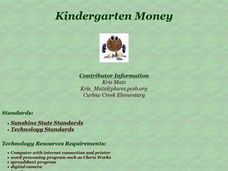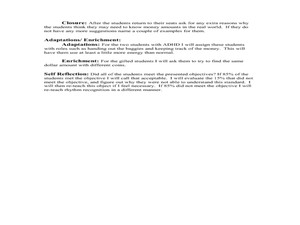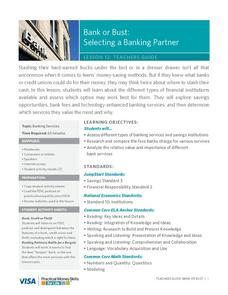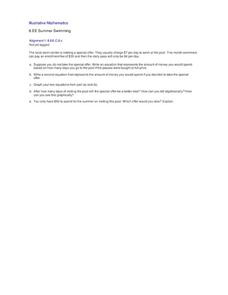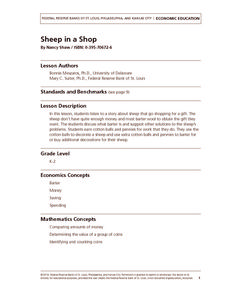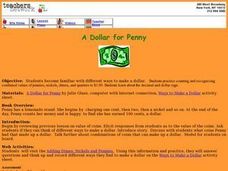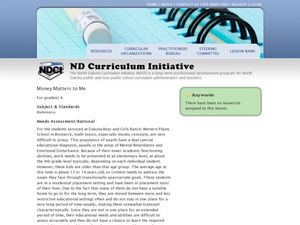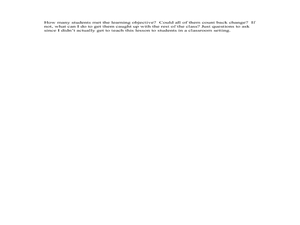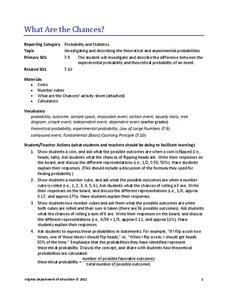Curated OER
Kindergarten Money
Students identify the various coins and their values through presentations, a rubric, a value pretest, and coin manipulatives. Money is incorporated into various activities whether at home or in school. Students create money webs using...
Curated OER
Making Amounts with Money
Second graders discuss how to make correct change. In this lesson plan on money, 2nd graders practice making an amount using the correct number of coins.
Virginia Department of Education
Spring Fling Carnival
Think critically — and linearly by applying linear equations to solve real-world problems. Young mathematicians write equations to model the profit on popcorn and cotton candy at a carnival and solve problems using these equations.
American Statistical Association
Exploring Geometric Probabilities with Buffon’s Coin Problem
Scholars create and perform experiments attempting to answer Buffon's Coin problem. They discover the relationships between geometry and probability, empirical and theoretical probabilities, and area of a circle and square.
Visa
Bank or Bust: Selecting a Banking Partner
Why shouldn't we just save all our money in our mattress? Couldn't our money disappear? Pupils discover the benefits of utilizing banks and credit unions for saving money, as well as how to evaluate different types of...
Curated OER
Multiplication and Areas
Upper graders solve problems involving measurement of squares and rectangles to practice multiplication skills, finding area, and calculating prices and percentages. A performance assessment is included.
Bowland
Explorers – Patrol Services
Far out — plan a trip to space! Aspiring mathematicians steer a space vehicle through an asteroid field, calculate currency exchanges to buy provisions, and determine placement of charges to blow up asteroids. Along the way, they learn...
Federal Reserve Bank
Your Budget Plan
What do Whoosh and Jet Stream have in common? They are both characters in a fantastic game designed to help students identify various positive and negative spending behaviors. Through an engaging activity, worksheets, and...
Illustrative Mathematics
Summer Swimming
Here is a real-world application for systems of equations. When is it better to pay an enrollment fee and lower daily rate, and when is it better to pay the regular price? The local swim center is having a special offer, reductions in...
Federal Reserve Bank
Sheep in a Shop
What do you think sheep might be able to barter when they don't have quite enough to buy a gift? Your pupils can find out this and much more during this lesson about Sheep in a Shop, spending, saving, and bartering.
Illustrative Mathematics
Heads or Tails
Heads! A great way to practice probability is to flip a coin in class. The provided data allows your mathematicians to predict the probability of heads in ten coin flips. Bring coins to class and allow your own trial of heads or tails....
Curated OER
A Dollar for Penny
Students demonstrate different ways to make a dollar. In this consumer math lesson, students read the book A Dollar for Penny and identify the value of each coin. Students determine combinations of coins that can make up a dollar.
Curated OER
Money Matters to Me
Fourth graders explore economics by identifying financial goals. In this consumerism activity, 4th graders discuss money matters and how to conserve an income when they get older in order to achieve their goals. Students collaborate in...
Curated OER
Money Bags
First graders identify coins and their value. Using a mixed set of pennies, nickels, dimes, and quarters, they sort the coins and identify the name of each coin and the value of one coin in each set. As the teacher announces a given...
Curated OER
Changing the Different Currency of Different Countries
Students change the money used in different countries into our currency. In this algebra lesson plan, students rewrite word problems using variables and inequalities. They label each unknown with a letter and identify the steps needed to...
Curated OER
Money Game
Fourth graders give change of one dollar. In this decimal and fractions instructional activity, 4th graders receive fake coins and discuss what they could purchase with them. Students go for a walk and spend one dollar...
Curated OER
Money and Business (Art)
Third graders investigate world currency by creating their own coin art. In this government activity, 3rd graders examine the characteristics of different coins and create their own design for a new one. Students discuss and...
Curated OER
Building Tolerance for Poverty in Math
Students explore approximate and exact solutions. In this interdisciplinary lesson, 6th graders will be placed in 'family groups' to create a budget that is subject to random events as chosen from the 'things happen' box. This lesson...
Curated OER
Let's Find Out About Money
First graders investigate the uses and development of money as part of the study of finance. They focus upon the recognition of different coins and identify the value of each. Then students solve problems involving money and coins.
Curated OER
Let's Find Out About Money
First graders identify coins (pennies, nickels, dimes and quarters), and their attributes, including physical characteristics and value.
Virginia Department of Education
What Are the Chances?
Take a chance on an informative resource. Scholars conduct probability experiments involving coins and number cubes to generate data. Compiling class data helps connect experimental probability to theoretical probability.
Practical Money Skills
Making Decisions
A set of quizzes and assessments would make a great companion to your lesson on making decisions and opportunity risks. Learners watch a PowerPoint before answering multiple choice questions about interest rates, saving money, and the...
Curated OER
Dollars and Sense
Fourth graders read "Starting a Business" and answer the question: "How could you design an ad to let the community know about the business described in the story?" Then, they illustrate a written ad that could be posted in the...
Curated OER
Technology - money
First graders trade coin amounts by using punch out coins. In this trading coins lesson plan, 1st graders use pennies, nickels, and dimes, and then trade them with each other in equivalent amounts. Students also complete money computer...
